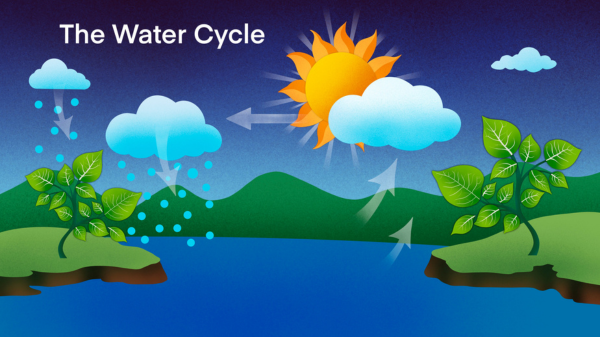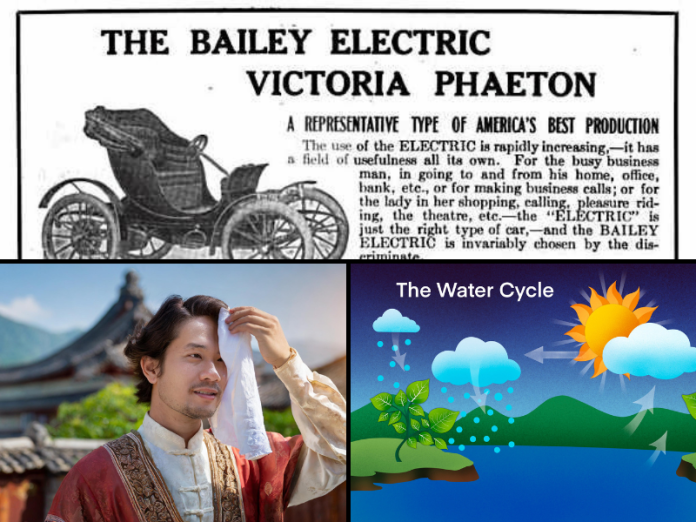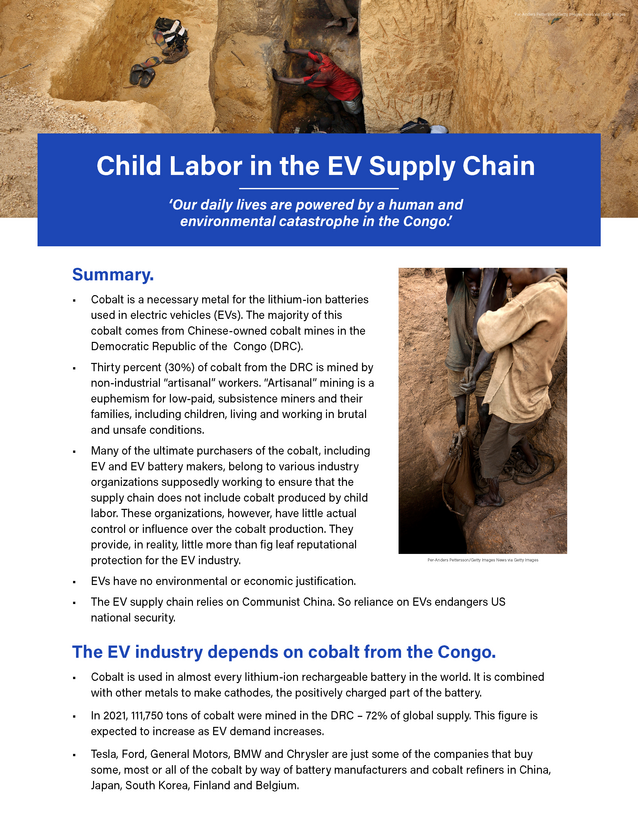YOU SHOULD SUBSCRIBE TO CLIMATE CHANGE WEEKLY.
IN THIS ISSUE:
- Is the Bell Tolling for EV Mania?
- Video of the Week: ESG On The Out?
- Northeast China Warmer in the 18th and 19th Centuries Than Now
- New Studies Show Climate Models Get Dominant Greenhouse Gas Wrong
- Podcast of the Week: Climate Science Is Being Subverted By Poor Metrics and the Pursuit of Consensus (Guest: Matthew Wielicki, Ph.D.)
- Climate Comedy
- Recommended Sites
Watch ALL the Presentations by the ALL-STARS of Climate Realism at the Archive of Heartland’s 15 Climate Conferences
Is the Bell Tolling for EV Mania?

Electric vehicles have been all the rage among politicians at least since President Barack Obama’s first term in office, but they’ve never really caught on among the unwashed masses, who actually want their cars to deliver them to their destinations in comfort in a timely fashion, toting everything and everyone they might want to take along, without blowing up while parked and burning down their residences in the process.
In truth, EVs had been tried and rejected long before that, largely because of the same problems they still have: low range and high cost. The first electric vehicle, a locomotive, was tested in 1837, nearly 60 years before the first vehicle powered by an internal combustion engine (ICE) entered service. Electric locomotives couldn’t even compete with steam engines fueled by coal. The first rechargeable batteries were created in 1859, and EVs still couldn’t compete.
Electric cars predated the first gasoline- and diesel-powered private vehicles, all without government support, subsidies, or tax credits, by the way, and they couldn’t compete. They still can’t compete. Yet now, in a vain quest to manage the climate, the government is putting its thumb on the scale to mandate and incentivize them with various types of support and regulations.
I have noted before that EVs are in general much more expensive than their roughly comparable ICE counterparts. As such, research shows that most EVs are sold to people in the top two income brackets, making the tax credits and other government support no more than welfare for the well-to-do and politically connected crony-capitalists.
Even with all that support, the chickens are coming home to roost. The stock price of Tesla, the top-selling EV maker, is in freefall, and the company’s declining dividends reflect that. EV rival Rivian is laying off workers as its stock has fallen dramatically on losses topping $1.5 billion. Another early EV entrant, Fisker, has already gone through one bankruptcy and may be lurching towards its second, its value having fallen to the penny stock level.
As EV inventories mount on dealers’ lots, Ford and GM, each of which announced billions of dollars in losses on its EVs, have reduced production lines and cut sales and production outlooks. After spending billions of dollars on various EV efforts, Apple, Inc. cancelled all its EV projects. If one of the most profitable, well-funded corporations in the world can’t make an effective EV and have it go mainstream, who can?
Energy analyst and Heartland Institute policy advisor Ronald Stein and my colleague Chris Talgo have both recently detailed the myriad problems facing EVs. Talgo points out that the two top issues limiting EVs’ appeal are those already known nearly 200 years ago: “range anxiety” and costs. I have written previously, at Liberty and Ecology, about the range problem EVs present to most normal drivers, pointing out that charging them would make various day trips I commonly take into two-day trips, at a minimum, and would cut the vacation part of week-long driving excursions in half or more.
Stein points out that used EVs are almost impossible to sell, and Hertz is cutting its EV fleet dramatically, purchasing new ICE cars to replace them.
Increasingly, even the mainstream media are being forced to acknowledge the drawbacks of the EV revolution which they have so breathlessly and brazenly promoted as a critical step in preventing climate catastrophe. The child and slave labor that EV technologies are built upon are becoming harder and harder to ignore, as is the environmental destruction caused by the mining of the minerals necessary for EVs to function.
Stories out of Oslo and Sweden, as well as in the states of Iowa, Michigan, and Minnesota, detail how electric buses have failed to complete their rounds during the winter, forcing those jurisdictions and others to pull them from service or severely truncate their routes. Of course, as shown by electric bus problems in North Carolina, San Francisco, and Wyoming, among other places, it doesn’t really have to be all that cold for electric buses to fail. The evidence suggests electric buses simply aren’t ready for primetime (or cost-effective). For most operations, traditional gasoline, diesel, and even natural gas buses are a better choice for schoolkids, commuters, and taxpayers.
A simple web search for “electric vehicles” and “fires,” or “electric bus” and “fires,” will turn up dozens if not hundreds of stories detailing how electric cars, scooters, and, increasingly, buses are spontaneously combusting, destroying property, and killing people in the process. Headlines note EVs, scooters, cars, and buses have become a significant fire hazard in New York and Connecticut, internationally in France and India, and during shipping. Some insurers no longer offer insurance on EVs or to those who store or transport them.
In the past week the hits on EVs just kept coming. Headlines in the Daily Mail on consecutive days declared, “Britain’s e-bus ticking timebomb: How nearly TWO THOUSAND electric buses worth £800m face urgent recall over fears they could … burst into flames,” and, “Electric cars release MORE toxic emissions than gas-powered vehicles and are worse for the environment, resurfaced study warns.”
The first story notes Great Britain’s Driver Vehicle Standards Agency issued an emergency recall of 1,758 double- and single-decker electric buses currently in service around the country (600 in London alone) because “there is no permanent solution to prevent future fires” tied to the buses’ power supply—i.e. the battery packs.
If electric vehicles had been brought out by automakers in the 1960s and 1970s, consumer advocate Ralph Nader would have had a fit and declared them “Unsafe at No Speed.” The U.S. Consumer Products Safety commission or other agencies would have almost certainly forced the makers to remove them from the market for safety reasons, instead of promoting them as they are doing now.
The second Daily Mail story, with facts confirmed by an article published at Fox Business News the following day, reported that because EVs are so much heavier than ICE vehicles, their tires wear out much faster, with the treads releasing 400 times more “toxic particles” into the air during operation than are emitted from the tailpipes of ICE vehicles. Considering pollution during mining and manufacturing, pollution during operation, and pollution related to charging (depending on the source of electricity used), the evidence suggests EVs are dirtier than the ICE vehicles they are supposed to be replacing on the grounds that they are better for the environment.
You can’t make these things up. Well, you could, but who would believe you?
With sales and stock prices falling and the media now starting to report on the problems with EVs, the scales are increasingly falling from the public’s eyes regarding EVs and governments’ ambitions for them.
The U.S. government never should have intervened in the market to promote EVs. There is no evidence we face a climate crisis outside of elites’ dogmatic rantings and the outputs of flawed computer models, and even less evidence that if there were a crisis EVs would prevent it instead of making it worse.
The question really is not whether the bell will toll to call an end of the government’s promotion of EVs, but how soon will it happen. With any luck, the coming election could prove a turning point if the turnaround does not happen before that.
Sources: America Out Loud; The Daily Mail; The Daily Mail; Climate Change Weekly; The Center Square; Liberty and Ecology; Junk Science
Get your Copy at Amazon TODAY!

Video of the Week
Climate Change Roundtable is now The Climate Realism Show. The same great climate news and analysis from The Heartland Institute’s world-class climate and energy experts, but a snazzy new name that gets right to the heart of what it is about.
On episode 100 of The Climate Realism Show, we look into the declining trends of the ESG. The Heartland Institute’s Jim Lakely, H. Sterling Burnett, and Linnea Lueken, plus special guest, anti-ESG investment guru Don Harrison look at the madness behind ESG and why it is now failing to maintain momentum as investors back away.
Plus, we will also have our regular weekly feature, Crazy Climate News.
Read the brutal truth about how battery production for electric vehicles cause immense environmental destruction and human tragedy.
Northeast China Warmer in the 18th and 19th Centuries Than Now

New research from a team of Chinese researchers published in the journal Forests finds the mountainous region of northeastern China was warmer in the late 1700s and mid-to-late 1800s than it is at present, despite carbon dioxide concentrations being much higher now.
Reconstructing temperatures for northeastern China for 1787 through 2005, the researchers found periods of both extreme cold and extreme warm temperatures lasting three or more years were common across the centuries studied. The scientists used tree-ring data collected from cores taken from Erman’s Birch trees in the transitional zone between forests and tundra in the Changbai Mountain (CBM) region. They found mean maximum winter temperatures were pivotal in determining the trees’ growth annually and on multiyear and multidecade timescales.
“After smoothing with an 11-yr moving average, cold periods occurred in 1822–1830 and 1957–1970, compared to the 1960 to 2005 calibration period, while a warm period occurred in 1787–1793, with rapid and sustained cooling being observed in the reconstructed series from 1790 to 1826 and again from 1939–1969,” the scientists found.
Using a 50-year time scale, the highest temperature during the 1787 to 2005 time frame occurred between 1844 and 1893, results confirmed by earlier studies, and the lowest temperature was from 1940 to 1993.
The scientists suggest the climate trends may be a response to solar activity:
Recent studies have underscored the strong correlation between changes in Earth’s climate and solar activity. The prevailing belief is that during periods of lower solar activity, such as the Dalton Minimum (c. AD 1790–1830) …, Earth’s temperature is expected to decrease. Our reconstruction reflects these expectations, displaying low values from AD 1790 to 1830 that coincide with the Dalton Minimum of diminished solar activity. Conversely, during periods of heightened solar activity, the climate tends to warm, as observed during the Roman warm period (400–10 BC) and the medieval warm period (900–1200 AD). … It was found that the upper temperature of the troposphere and stratosphere was synchronous with the 10–12 years cycle of solar activity.
Sources: Forests; No Tricks Zone
Heartland’s Must-read Climate Sites



New Studies Show Climate Models Get Dominant Greenhouse Gas Wrong

Despite being the dominant greenhouse gas in the atmosphere—making up approximately 97 percent of all atmospheric greenhouse gas—water vapor is largely ignored in the discussion of climate change. It is generally treated as a nearly constant variable in climate models, only perturbed as a feedback loop in response to rising temperatures.
However, new research published in the Proceedings of the National Academy of Sciences suggests climate models do not accurately model the response of water vapor to warming. An accurate understanding of the water cycle is critical, the authors write:
One of the most pressing issues facing society and ecosystems as the planet warms is the impact of a changing hydroclimate and its associated effects on drought, wildfire, and heat extremes. This is particularly true in arid and semi-arid regions where water resources are limited, and wildfire and heat extremes are already a significant threat.
The researchers note the anthropogenic climate change theory holds that atmospheric water vapor should increase as the planet warms, because a warmer atmosphere can hold more moisture. Climate models reflect this belief, treating rising water vapor as causing a positive feedback to rising temperatures, further tending to warm the planet. That, however, is not what the data presented in this new paper shows. Examining trends in vapor pressure and relative humidity in the arid and desert southwestern United States, which they used as a case study, the scientists found water vapor was not responding to warming as predicted by the theory and climate models:
Over the arid/semi-arid regions of the world, the predominant signal in all model simulations is an increase in atmospheric water vapor, on average, over the last four decades, in association with the increased water vapor–holding capacity of a warmer atmosphere. In observations, this increase in atmospheric water vapor has not happened, suggesting that the availability of moisture to satisfy the increased atmospheric demand is lower in reality than in models in arid/semi-arid regions. This discrepancy is most clear in locations that are arid/semi-arid year-round, but it is also apparent in more humid regions during the most arid months of the year. . . .
This is contrary to all climate model simulations in which [water vapor] … rises at a rate close to theoretical expectations, even over dry regions. This may indicate a major model misrepresentation of hydroclimate-related processes; models increase water vapor to satisfy the increased atmospheric demand, while this has not happened in reality. Given close links between water vapor and wildfire, ecosystem functioning, and temperature extremes, this issue must be resolved in order to provide more reliable climate projections for arid and semi-arid regions of the world.
As I’ve discussed repeatedly in previous issues of Climate Change Weekly, the models don’t account for clouds, large-scale natural ocean cyclical currents, volcanic activity, or changes in regional topography. Now it turns out they inaccurately model the response of water vapor, the dominant atmospheric greenhouse gas by far, to warming conditions.
As bad as model projections of warming have been, much less the ancillary catastrophic climate changes that are forecast to flow from that warming, it is unclear to me what, if anything, the models get right. In what ways do climate models accurately model the climate, and if they don’t, what are they good for? Certainly not policymaking.
Sources: No Tricks Zone; Proceedings of the National Academy of Sciences
Podcast of the Week
Dr. Matthew Wielicki has had a heck of a year, voluntarily leaving academia when he found the pursuit and promotion of knowledge was being subverted by an effort to enforce consensus on researchers. Nowhere is this more evident than in the field of climate change. He now refers to himself as “earth science professor in exile.”
Recently he has written about why “global average temperature,” is a poor metric for climate change, and how poorly conducted, alarming climate research is being heralded by the media, and not being called out by scientists — all in an effort to motivate climate action which will rob our children of their money, freedom, and mental health.
Subscribe to the Environment & Climate News podcast on Apple Podcasts, iHeart, Spotify or wherever you get your podcasts. And be sure to leave a positive review!





























